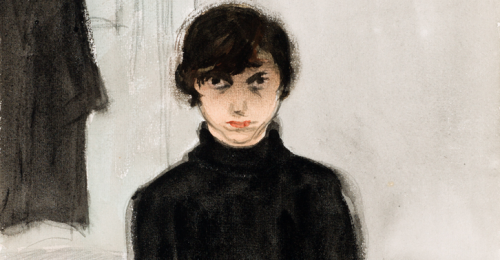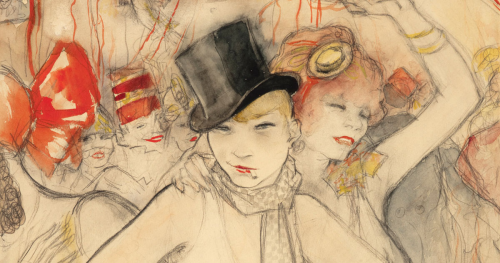NOVEMBER 21: Jeanne Mammen (1890-1976)
The influential painter and illustrator Jeanne Mammen was born on this day in 1890. Jeanne’s work is most famous for being apart of the New Objectivity and Symbolism artistic movements, as well as for depicting a specifically lesbian perspective of women’s bodies and the Berlin nightlife of the Wiemar Era.

A self-portrait by Jeanne Mammen c. 1926 (x).
Jeanne Mammen was born on November 21, 1890 in Berlin, Germany. Her father was a wealthy merchant and was able to afford for Jeanne to live out her youth and be educated at a school in Paris. She would eventually go on to advance her artistic studies in both Brussels and Rome. In 1916, her family was facing internment by the French government and so her parents fled to Amsterdam while Jeanne moved back to Berlin. On her own for the first time in her life, Jeanne’s first years as an adult in Berlin were incredibly influential on her life and work. Due to the fact that the French government had confiscated all of the Mammens’ property, she struggled to make ends meet and ended up interacting with people of varying class background for the first time in her life.
Throughout the 1920s and 1930s, Jeanne threw herself into Berlin’s LGBT social and artistic scene. She found work illustrating movie posters and caricatures for satirical magazines, but her true passion was her watercolors and illustrations of the lesbian nightclubs and Bohemian bars she frequented in her daily life. Throughout the 1930s, she published what is now considered some of her most important work - a series of 8 lithographs for Pierre Louÿs’s lesbian poetry collection, Les Chansons de Bilitis. When her artwork of women was displayed at a 1933 exhibition, Nazi officials interrupted the event and deemed Jeanne’s work as “degenerate” and “Jewish.” She was forced to revert back to advertising and abandon the leverage she had been making as a distinctly lesbian artist.

One of Jeanne Mammen’s iconic depictions of Berlin’s popular lesbian clubs, She Represents, c. 1927-1930. Historian Richard Meyer writes, “She Represents, for example, was first published in Curt Moreck’s 1931 Führer durch das ‘lasterhafte’ Berlin (Guide to Immoral Berlin), a delightfully lurid handbook to the sundry, primarily nocturnal, diversions on offer in the metropolis. Mamman’s picture appeared under the heading ‘lesbian locales’, in chapter six of the guidebook, a chapter that also featured sections of ‘get together spots for homosexuals’, ‘night baths’, and ‘here are the transvestites’.” (x).
In the 1940s, Jeanne experimented with Cubism but did not begin exhibiting her work once again until after World War II. In her later years, she focused on collages and designed the sets for the well-known cabaret Die Badewanne. She would pass away fairly unknown on April 22, 1976, but her work began to be rediscovered and admired by German artists in the 2010s. In 2013, her more abstract pieces were featured in an exhibition during Berlin Art Week titled “Painting Forever!”
-LC























